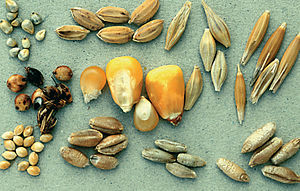**1. Cereal Overview:**
– Cereals were domesticated around 8,000 years ago, playing a significant role in the rise of complex civilizations.
– Cereals belong to the grass family, producing edible grains like maize, rice, wheat, barley, sorghum, and millet.
– Most cereals are annual crops adapted to temperate or tropical climates, with some exceptions like rice.
– The Green Revolution in the 20th century greatly increased cereal productivity worldwide.
– Cereal strains are bred for consistency and resilience, facing constraints like plant diseases and pests.
**2. Cereal Production and Trade:**
– Maize, wheat, and rice dominate global cereal production, with oats and rye production levels decreasing.
– Cereals are the largest commodities globally by tonnage, heavily traded commodities.
– Different cereals serve as staple foods in various regions, impacting global food security.
– The US is a significant maize exporter, while India leads in rice exports.
– Cereals are traded as futures to manage price risks, with disruptions like climate change impacting trade.
**3. Nutritional Aspects and Consumption:**
– Cereals are rich in carbohydrates, fiber, and essential nutrients, providing energy for humans.
– Whole grains offer more nutrients compared to refined grains, with fortification addressing nutrient deficiencies.
– Including a variety of cereals ensures diverse nutrient intake, with different cultures having unique consumption methods.
– Processing affects the nutritional value of cereals, recommending whole grains for better health.
– Proper storage is crucial to maintain cereal quality and prevent spoilage.
**4. Environmental Impact and Sustainability:**
– Cereal farming can lead to soil erosion, biodiversity loss, and environmental pollution from excessive fertilizer use.
– Climate change affects cereal crop yields and quality, necessitating sustainable farming practices.
– Intercropping cereals with legumes improves soil health and reduces fertilizer use.
– Sustainable agronomic practices can mitigate the environmental impact of cereal farming.
– Innovations in cereal production techniques are crucial for sustainability and environmental conservation.
**5. Challenges and Opportunities in Cereal Agriculture:**
– Climate change poses a threat to cereal production and food security, impacting rising food prices.
– Research and innovation are key to addressing challenges in cereal agriculture.
– Sustainable agricultural practices can help mitigate environmental impacts and ensure food security.
– Technology advancements in cereal, pulse, and oilseed production are vital for future agricultural sustainability.
– Balancing food security, conservation, and agricultural productivity is essential in managing global challenges in cereal agriculture.
A cereal is a grass cultivated for its edible grain. Cereals are the world's largest crops, and are therefore staple foods. They include rice, wheat, rye, oats, barley, millet, and maize. Edible grains from other plant families, such as buckwheat and quinoa are pseudocereals. Most cereals are annuals, producing one crop from each planting, though rice is sometimes grown as a perennial. Winter varieties are hardy enough to be planted in the autumn, becoming dormant in the winter, and harvested in spring or early summer; spring varieties are planted in spring and harvested in late summer. The term cereal is derived from the name of the Roman goddess of grain crops and fertility, Ceres.


(middle) sorghum, maize, oats
(bottom) millet, wheat, rye, triticale
Cereals were domesticated in the Neolithic, some 8,000 years ago. Wheat and barley were domesticated in the Fertile Crescent; rice was domesticated in East Asia, and sorghum and millet were domesticated in West Africa. In the 20th century, cereal productivity was greatly increased by the Green Revolution. This increase in production has accompanied a growing international trade, with some countries producing large portions of the cereal supply for other countries.
Cereals provide food eaten directly as whole grains, usually cooked, or they are ground to flour and made into bread, porridge, and other products. Cereals have a high starch content, enabling them to be fermented into alcoholic drinks such as beer. Cereal farming has a substantial environmental impact, and is often produced in high-intensity monocultures. The environmental harms can be mitigated by sustainable practices which reduce the impact on soil and improve biodiversity, such as no-till farming and intercropping.
